
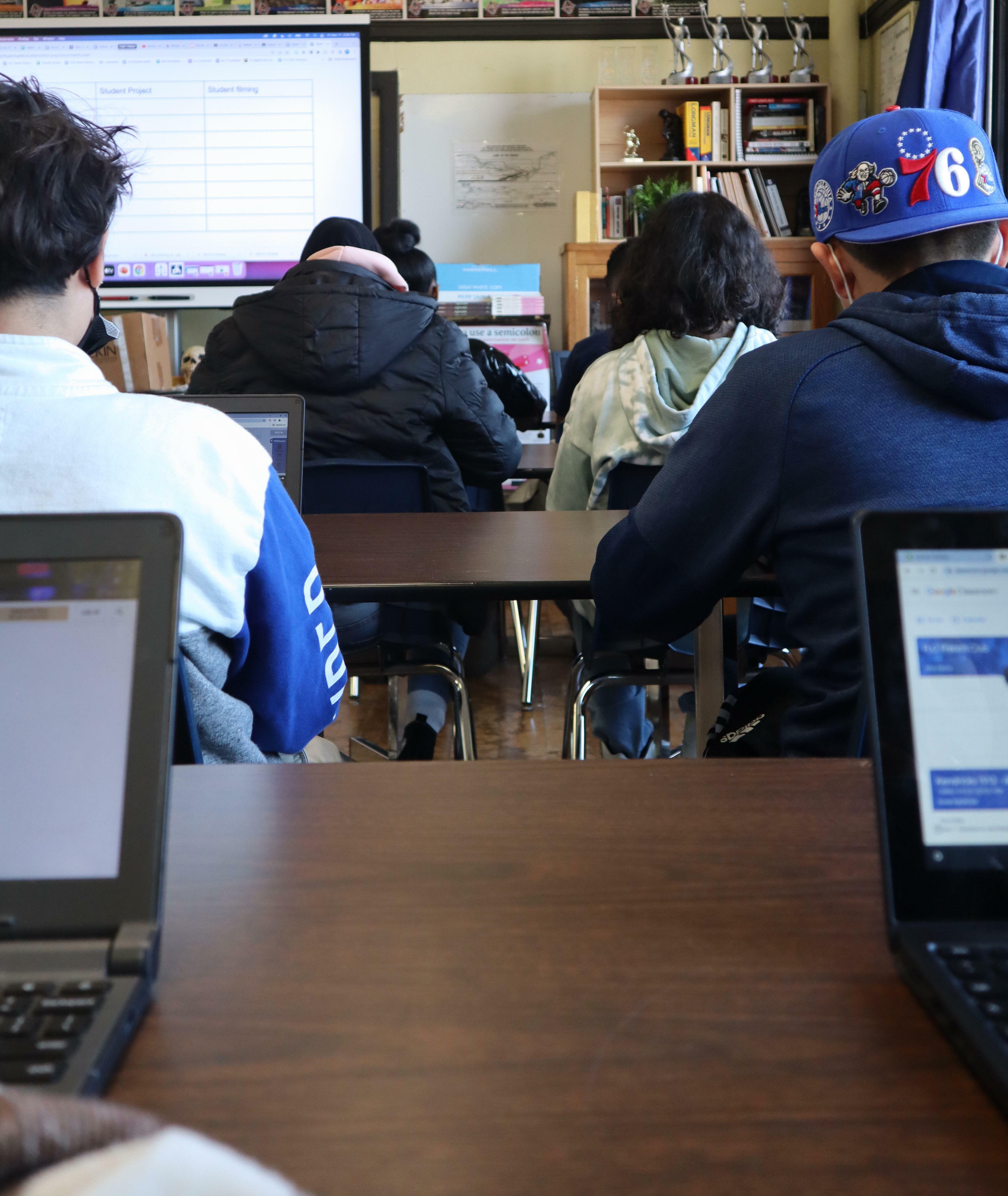











Franklin Learning Center’s boys var sity basketball season was from Decem ber 10th through February 17th. Mak ing a comeback from quarantine, the first full year since COVID-19 disrupted the high school basketball season, the Bobcats faced down various obstacles with their dedication and teamwork.
The 2021-2022 season has been the boys’ first full season since COVID-19 hit.
“Well, when we did virtual last year and came back, we didn’t even have a gym to practice in,” Coach Michael Gardner said. “We were practicing in the cafeteria, the hallways, you know, the fitness room. The only time we ever shot a basket as a team was when we played in the games we played.”
Returning from a year’s worth of no gym practices resulted in a rough beginning for the Bobcats with their first three games being losses.
“I like being in person,” says ju nior, Dominic DiGiorgio. “I strug gled a lot online. So being in person really improved my mental health.”
Players on the team have started to re gain focus and better themselves since leaving the confinement of online school.

In the beginning of the season, there was a lot of disconnect within the team. Losing games back to back was hard for the team’s confidence. After their three loss streak, the Bobcats managed to win five in a row, something that has not happened in FLC basketball history since 2007.
Despite the win streak, the Bobcats took many doubts into their game against Sayre High school, the number one team
in the conference at the time. But the Bobcats won 76-73. They won their next game as well, to make it to the playoffs.
“I remember when we got hit with the quarantine issue,” freshman Aldo Collado said. “There were about five players and the head coach who were out quarantining. So the rest of the people on the team and the assistant coach kept going. They won, I think six games in a row, which was the big streak they had. After everybody else came back, we all were better than before. We got stronger as a team. We beat teams like Sayre, which was a matchup that no body thought we were going to win.”
The Bobcats continuously defied the odds to achieve a successful game
along with strengthening their bond.

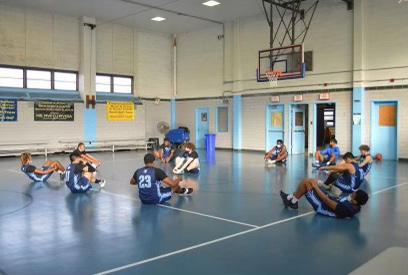
One of the last games the Bobcats played was very intense. Going against each other were Franklin learning cen ter’s Bobcats vs West Philadelphia’s Speedboys. The uncertainty of how the game was going to be played out gave everyone on the team mixed feelings.
“I was worried that they were going to be tight,” Assistant Coach Andre Bright said. “We have five seniors and this was their first opportunity to play in the playoffs. I was just worried that they would be too nervous or too tense playing the game, but they came out with none of what I was expecting,”
The Bobcats did lose, 78-49, but re gardless of the loss, they were able to be come closer as a team. This was a hum bling and disappointing game that ended up making the team stronger as a whole. The season ending resulted in a lot of re evaluating but unforgettable experiences.
“There’s no reason anybody should be disappointed in this season,” Aldo Col lado said. “We played well. We played hard. We beat some teams that nobody expected us to beat. And we contin ue to make it known what we can do.”
Players showed amazing sportsman ship and defeated doubts and odds while conquering many achievements this year.
“So many years of not being success ful, to then perform as well as we did, I thought it was a tremendous accomplish ment,” Coach Bright said enthusiastical ly. “I told them how proud of them I was because of how hard they played and the level of success that they had achieved.”
Being the last year for many players play ing high school basketball, there is a lot of sor row being expressed throughout the team.
“There are so many years behind the jersey I wore,” said FLC’s senior, John Daly, who averaged 15 points per game. “So it sucks that this is the last time I’m ever going to wear it.”
John has played basketball for FLC since his freshman year and taking it off was a difficult thing to do, as well as for the other seniors: Marte Jordan, LeMar cus Smith, Joe Sherman, and Mikel Brown.
The year has been filled with many ac complishments from the team. Continu ously beating the odds as well as beating some of FLC’s personal basketball records. The 2021-2022 basketball season has al lowed many players to leave an impact on the players of the future. This season gave the opportunity to the players to be able to and grow as individuals and con quer the world of highschool basketball.
All advertisers are subject to approval by The Flash FLC. We reserve the right to refuse advertisements. The deadline to reserve advertising space in The Flash FLC is at least one week prior to publication. Online advertisements can be placed as requested. Payment should be made in cash. Please note: first-time advertisers must prepay.
The Flash will be guided in the publication of all material by a concern for the truth, for human decency, and for human betterment, remembering that the test of good journalism is the measure of its public service.
The Flash will strive to provide a comprehensive and intelligent account of events in a meaningful context.

The Flash will strive to be a leader of student opinion through its editorials.
The Flash will be a public forum for promoting change and for the exchange of comment and criticism through its letter to the editor and Opinion pages.
A full list of policies and procedures can be found at theflashflc.org/constitution
The Flash is a member of the Pennsylvania School Press Association and the Columbia Scholastic Press Association.
The Flash encourages readers to contribute through letters, guest columns, and story ideas. Suggestions will be considered for future publication. Letters should not exceed 300 words in length.
Press run is 750 copies. Copies are provided free of charge to students, faculty, and staff.
Spring sports are just beginning and many players are questioning wheth er they will have spectators this year.

Softball is a sport that takes a lot of en ergy and passion and takes place outdoors. It being an outdoor sport is significant be cause with COVID precautions, people will be able to stand the required amount of feet apart and be able to stay safe while cheer ing on Franklin Learning Center’s Bobcats.


Keep in mind that this year’s softball Bobcats are not only FLC’s girls players, but Parkway Center City players as well. A partnership of the two schools allows for the players to make friendships and grow together as a team. Spectators from both schools would be able to come to gether as one to cheer on the softball girls, allowing them to feel a sense of accom plishment when coming together to play.
Returning players were asked if they would like spectators to come to their games and some had sim ilar ideas as to how it would be.
Ashley Soto is a returning softball play er and a senior at Parkway Center City.
“[Spectators] tend to cheer a lot,” Soto said. “They make it more lively and they make it more fun for the players.”
“I do think it is good to have spectators when they bring a positive influence on us because it helps us feel supported and feel welcoming when we know we have people watching us,” Valdez said. “It also helps us grow and develop as a team and having people there supporting keeps us excited and pumped up for game time. It also makes it more fun and energetic.”
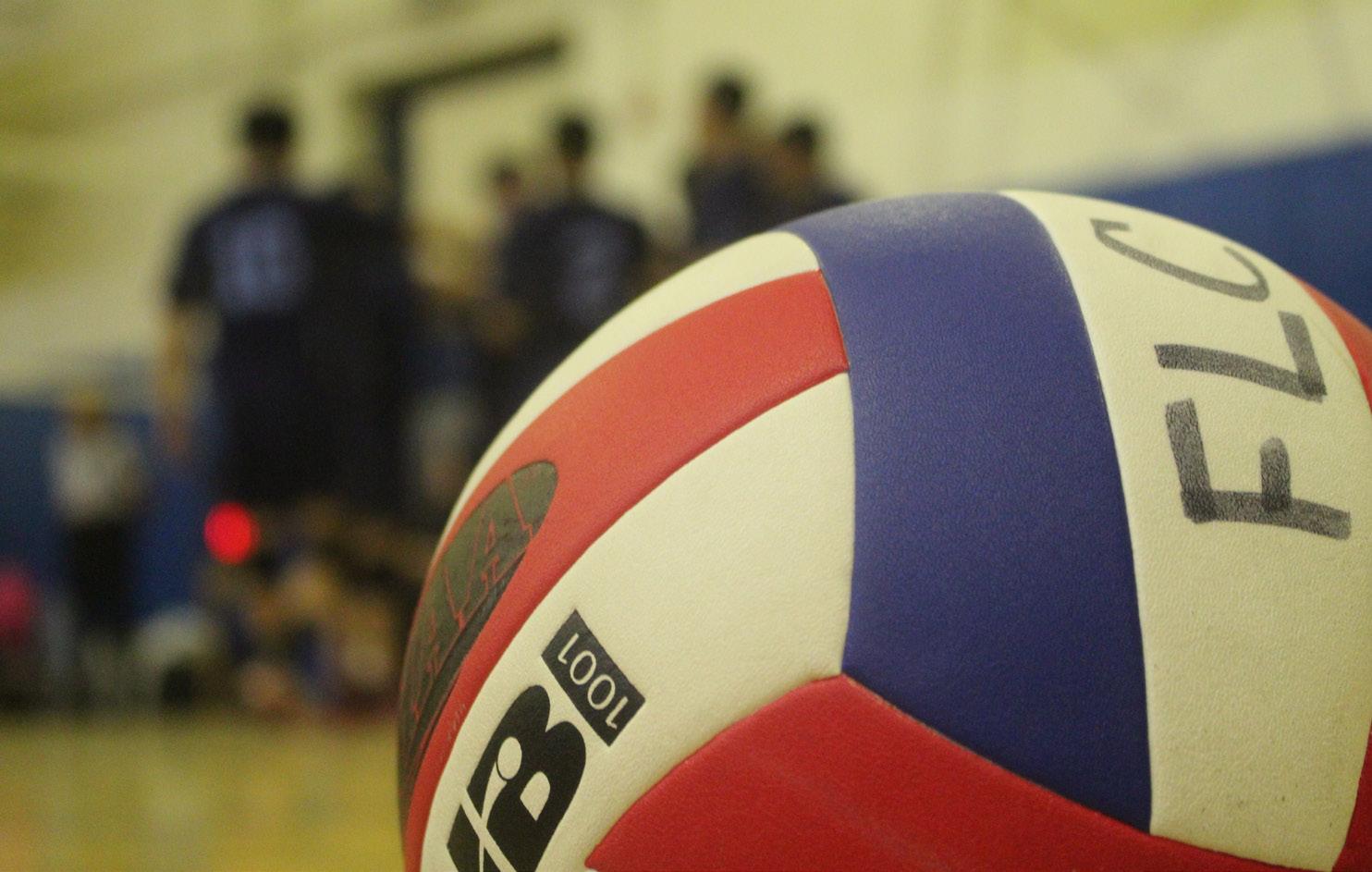
Kylee Taylor, a senior at FLC and a returning softball player, knows they haven’t had as many spectators as oth er FLC sports teams.
“I would like spec tators at the game con sidering that at the boys basketball game, they have many spectators and their games are indoors,” Taylor said. “Ours are outdoors which makes it possible so spectators can be comfortable enough to
have their own space. We don’t get near ly as many spectators as the other teams.”
Having spectors can do many things for the softball girls, but Taylor made it clear that it would greatly improve school spirit.
“We need better school spirit,” Taylor said, “and I think that more people com ing to our games will improve our school
great thing for the players, Coach Me gan Condit says it can be complicated.
“I have mixed emotions about specta tors,” Condit said. “I think that it can be a positive experience to have spectators at our games, if they themselves remain pos itive. I do not like spectators who create drama. I do not like the drama that comes along with spectators heckling, our team or the other team. Sometimes they think that they’re helping us out by heckling the other team by screaming when the pitchers about the pitch or clapping when the batter is about to swing. Whatever it may be, I don’t find that helpful. I find it unsportsmanlike. But if we have spectators who are willing to stay positive, and follow the same sports manship rules that we as players and coach es follow, then that would be wonderful.”
spirit. Make us play better as a team and give us the spirit we need as players.”
Although having spectors can be a
Having spectators would improve the FLC girls softball players spirit, meaning it would improve other spring sport teams as well. Boy’s baseball is outdoors as well as track and field and girls flag football. Having spectators cheering the players on while they play can grow their confi dence and help them become more com fortable with their fellow team players.
Many people often associate At tention Deficit Hyperactivity Disor der symptoms in school with the stu dents. However, some teachers struggle with it as well, but are just overlooked.
Franklin Learning Center’s World His tory teacher, Kathryn Reinl, has struggled with ADHD-like symptoms for a while, but it wasn’t until this year that she was diagnosed.
“It was really validating because so many other doctors had kind of dis missed it. And I felt like someone was finally listening to me,” Reinl said.
Many people often have misconceptions about what ADHD is, which is most likely a reason why Reinl had difficulties getting a proper diagnosis up until this year. A ma jority of people often believe that ADHD is about not being able to sit still and focus, but there’s more to it than that.
“It’s more like you have trouble or ganizing your thoughts or prioritizing tasks,” Reinl said. “There are, you know, fidgeting and distractions as well, but it’s more about what they call, execu tive dysfunction, where you have trou ble making those brain level decisions.”
The executive function part of ADHD has had a big effect on Reinl. It’s been difficult for her to keep and build rela tionships with other people due to this.
“I tend to just disengage if I’m get ting overwhelmed in a conversation or I’ll just forget to respond to someone,” Reinl said. “Trying to make new friends or build connections with new people can definitely be hard because I’m not always on top of staying in touch with people.”
Being able to build strong connections with new people is an important skill for a teacher. Reinl started teaching in the Fall of 2018. Her experience as a new teach er wasn’t one that many would approve.

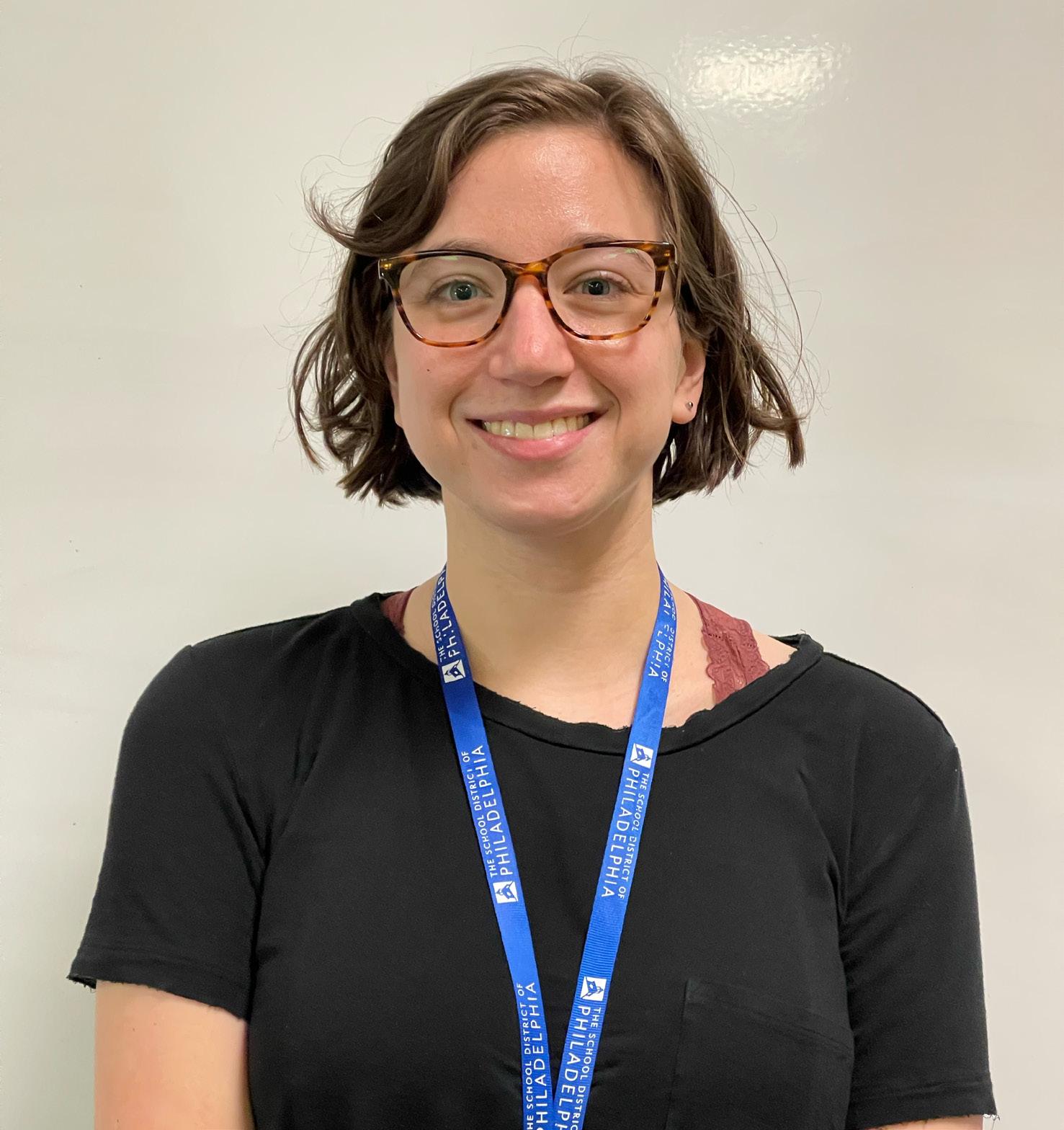
“It was hard. I was in a really under funded school, and I was teaching two content areas. I’m only certified to teach one and I didn’t feel like I had a lot of sup port. It was overwhelming,” Reinl said.
As a teacher with ADHD, struggles are bound to come. Reinl and her en deavors made her the person she is today.
 By: Dareen Alfroukh
By: Dareen Alfroukh
Many important jobs go unnoticed, stuck in the shadows. It’s no different con cerning schools. Sherrie Richardson works as a climate staff member at Franklin Learning Center and most students don’t even know her name.
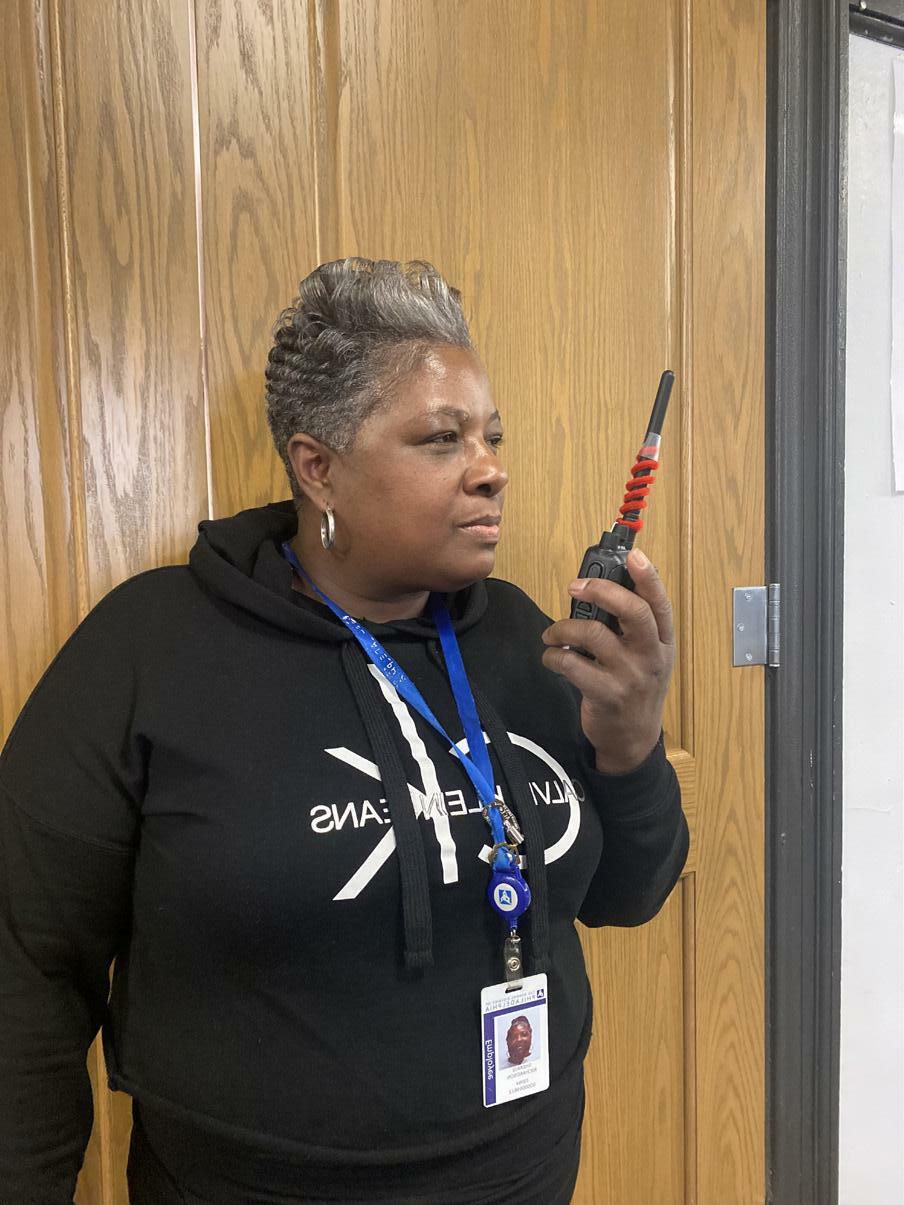
As someone that sees students go through harsh conditions, Richardson tries to help all the students as best she can, knowing what the stress feels like.
“I try not to let too many things stress me out, I’ve been dealing with kids for a long time.”
Throughout all her long years with kids, Richardson has encountered a variety of
“I just feel like having had that ex perience makes me more empathetic to students,” Reinl said. “Even if they don’t have ADHD. Being able to understand,
different students. Some of which have been rude and disrespectful, which can make her job difficult, but Richardson does her best to try and understand.
“All the stress, all the disrespect you have to deal with some of these children.”
Richardson eventually realized that there are a number of reasons why they can be disrespectful. Homelife can definitely be one of them.
“I knew quite a few kids and quite a few families personally. Even some of my own family members. Some didn’t have the proper things at home. The home wasn’t clean. They didn’t get meals regularly.”
When dealing with the stress and the harsh part of the job, Richardson needs something to keep her calm and collective.
“So in the morning, what I do is, I put some gospel music on in the morning which kind of gets me together. Gets me going. I pray between four and five in the morning. I pray a lot right now.”
She sees all kinds of students. Good and bad, loud and quiet, hopeless and hopeful, but she tries her best to help every stu dent she can.
“I try to offer a lot of stuff. My daughter has young children, so she had bags of clothing and what she’ll do is she’ll say “Mom, you know somebody that needs them?” So that’s what I do, I give them basic clothes.”
A simple act of kindness from Richardson can go a long way for that student. “I make gestures more or less.”
most of the time, that it’s really hard to sit and be quiet for a period of time.”
“Is there anything MJ brings to the class room that other teachers don’t? Happiness.”
Caring, kind, warm, fun, easy to re late to, and friendly. She isn’t a teach er, although she is respected as one, she’s more like a friend to the stu dents here at Franklin Learning Center.
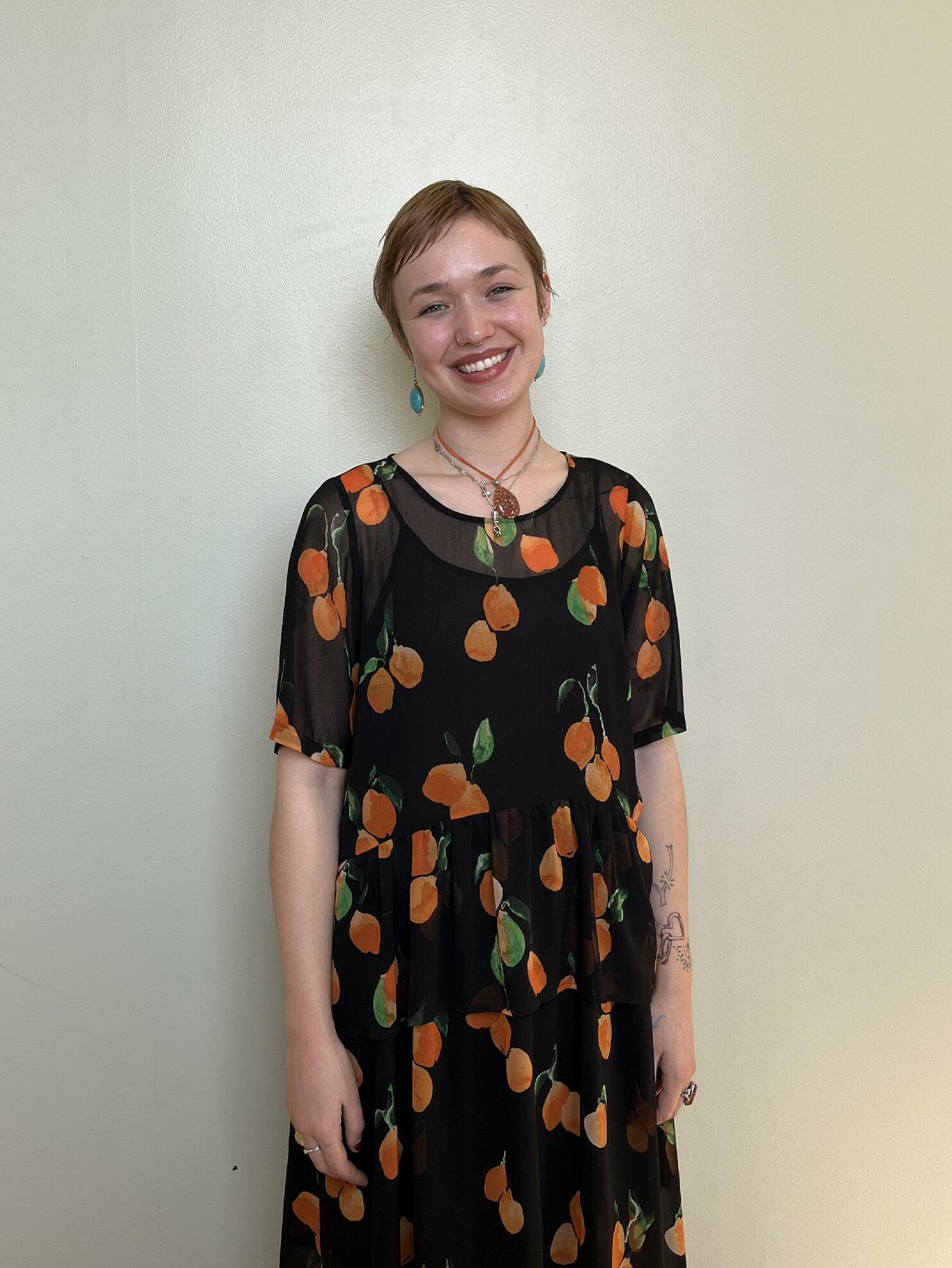
This year, Mikaela “MJ” Swanson is Franklin Learning Center’s Teaching Art ist. She comes from a program called Artist Year, which is part of a larger program called Americore. Each year FLC partners with their organization to bring a teaching artist to this school. Vocal Music teacher Michelle Frank describes getting MJ as this year’s teaching artist as “extremely fortunate.”
So what does MJ do here at FLC? Teach? Not quite. MJ’s job here con sists of making relationships with the students and faculty members at FLC.
“The best way to describe my work,” she said “is that I come in to support the arts department and bring arts education into schools. And that can look a lot of different ways depending on where you’re placed. Luckily, I’m at a school with a re ally strong arts department so I don’t have to teach curriculum and I don’t have to develop any coursework which gives me a lot of time to make a lot of relationships with you all and support Ms. Frank and Mr. Sharp in other projects. My favorite part is that I get to hang out with you guys.”
Students are feeling the love.
“I feel more comfortable with her than with some of the teachers I’ve known here for like the past four years,” senior Yeshua Irizarry said.
MJ relates to the students here as well.
“I sometimes feel like I’m also a student again,” she said. “So when I’m in the class room, it feels very much like my experience in high school as well. For me. It feels like this is exactly where I’m supposed to be right now. Because it reminds me a lot of what I used to do and I think that that helps me in being a support system for the students because I get it and I know what it’s like to be in your position as well. And I know that sometimes, although you are here to study music, sometimes you’re like, man, I don’t have the juice today. You know what I mean? I feel like I have a good understand ing of what it’s like to be on both sides now.”
The COVID-19 pandemic opened MJ’s mind to new knowledge and experienc es even if it took away some things as well.
“I was finishing up school. It’s really hard to be a music student online, and I really felt a lot of sadness. I felt this disconnect from my peers that was really difficult to deal with. You know, I think the pandemic kind of killed off acquaintances. We don’t have a lot of acquaintances anymore. Now we’re starting to get back into, you know, a non-virtual world. I think we’re starting to see people that are like preliminary friends, but for a long time, the only people I saw were my super super close friends who were roommates and my family. I think I also felt a lot of disconnect from my fellow music students. And that was something that was my favorite thing about going to music school. Your peers were your friends and they were also your bandmates, studio mates, and co-producers. Having a com munity of people who are all interested in the same kind of thing as you, you get to mix the professional and the personal in that way, which I really loved and the pandemic made it really hard to do that.”
The pandemic also helped MJ dis cover some new things about herself.
“It also gave me a lot of time to focus on my own individual songwriting and on my own music. I think it gave me a
lot of opportunities to be like okay, “I re ally want to make this kind of music” or “I want to make this kind of song.” And I can’t meet up with someone who’s better at it than me, so I just have to teach myself. I taught myself how to play guitar, how to produce a song. I had to teach myself
how to score a film. I spent a lot of time by myself in my room developing my skills, and it gave me a lot of confidence in the fact that I can teach myself anything.”
MJ talks a lot about the music depart ment we have here at FLC and how great it is, but she loved music before coming to FLC.
“I genuinely have always been really musically minded. My grandma always said I had a song in my heart, that’s how she phrased it. And I really think that’s true. I sort of was always writing little songs and as I got older my dad was like, “Hey, you should focus on this a little more.” He taught me how to use recording equipment at home and it just sort of snowballed from there.”
Finding her passion for mu sic, MJ decided to pursue it.
“I started going to art school in seventh grade and I was singing all through middle school and high school. Toward the end of high school, I was like, ‘Okay, I love per forming but I want to find a way to have a job that is artistic, but doesn’t involve me singing all the time and that kind of led me down the production route and doing more recording arts. I continued to study recording arts in college, and now I’m kind of doing a mix of stuff, right?’ So I’m teaching music here at FLC, but I’m scor ing films and I’m performing on my own and I’m writing my own music and now I’m kind of looking at some other work too. So yeah, I mean, I just feel like music is the one thing that I have consistently loved and I feel this sort of soul connection to music. Music is the one thing that I will forev er, every single day, think, I love this and I feel the most self when I’m doing this.”
Working somewhere where you can laugh while you work is proba bly a dream come true and MJ seems to be living that dream with her students.
“I think I laugh, belly laugh, every sin gle day. Because you guys are just so fun ny. You guys just say the funniest stuff. You guys don’t even know how funny you are, I like that you guys are just hilarious.”
Music might be MJ’s favorite thing, but here at FLC, it’s the students and the entirety of the music department.

“I just love the students here and I love Miss Frank and I love Mr. Sharp and I love the music department. I love watching students gain confidence in themselves. I love watching the musical come togeth er and watching kids who were really shy and never said anything, get up on stage and they’re bombastic, incredible per formers, that makes my heart want to ex plode. I think it’s the little things right? You’ll think that you’re not really connect ing with a student, they don’t seem to care about you, they’re not giving you much and then they come up to you after class and they’re like, “Hey, man, give me a stop.” That means so much to me. And y’all don’t know that because I don’t think it really fazes you, but that means so much to me to know that, me just being in the class room, is positive and helps in some way.”
MJ is only at FLC for the year, but is already making an impact on her students and her fellow staff mem bers. Ms. Frank knows how import ant it is for FLC to have people like MJ.
“I think we need more peo ple like her,” Frank said.
Irizarry knows the dif ference MJ makes too.
“She definitely cares about every body and how they feel,” he said. “I no ticed that when somebody is down or somebody feels or looks upset, MJ makes sure that they’re included.”
Although MJ has only been here for a short amount of time, she’s defi nitely made an impact in her stay.
“I feel like there’s so much more to MJ that I don’t know because I’m just a stu dent now,” Irizarry said, “but I can’t wait to learn more about her after I graduate and after she leaves to see what she does.”
Picture this, you’re winding down af ter a long day, blasting your favorite song in your headphones, and painting a mu ral that you know you’ll be proud of for years to come. Sounds relaxing, doesn’t it? Well, you don’t have to imagine it for much longer because Franklin Learning Center’s Mural Club can make it a reality. It’s possible you haven’t heard of the Mu ral Club until now, but I’m almost positive you’ve seen their works around the school. Whether it’s the murals across the third and first-floor walls or in the 3rd-floor girl’s bathroom, you’ve passed at least one while rushing to get to your next period class.
There are three steps to creating a mural:
Brainstorming: First, you have to come up with a concept. Because this is a group project, the Mural Club has to take their time to make sure everyone is on board and everyone knows what their job is, but they’re always open to ideas for their next mural. Maybe there’s a color palette that you think would make FLC look much bet ter and want to see. Or there’s an idea that you want expressed. Maybe even a funny picture that you think should be an inside joke among FLC! There’s a whole range of possibilities and each mural can serve a dif
ferent purpose. What would you like to see?
Sketching: Before you start the paint ing, it’s a good idea to sketch out your painting first. It doesn’t have to be iden tical to the final product, but more of a guide for what you want to do. You can enlarge the image in a variety of ways, but you can also just freehand.
Painting: Then there’s painting, the Mural Club usually starts with priming the canvas which is making sure it’s light enough and then they layer colors to suit the mural. It’s really straightforward, but you should never be afraid to mess up. Creativity can turn mistakes into some thing new. I asked Zaynab Hajali, an 11th grader here at FLC and a long-standing member, about what her favorite part of the Mural Club was and her answer was “My favorite part is basically painting. I love painting... but I don’t get to do it very often at home, so I like that there’s a club at school that allows me to do so.”
You don’t have to be an art major to join, in fact, Hajali is a Medical Assisting Major. It’s a perfect opportunity if you are interest ed in art to gauge your skills and get more experience. Even if you don’t know if you like art, this would be the perfect time to find out. Plus, you don’t have many respon sibilities except for showing up and being consistent each week. This is supposed to be a relaxing experience that also gives you a sense of fulfillment, not another assign ment to finish, so don’t think of it as such.
The Mural Club meets every Wednes day from 3-4 pm in room 302. Currently, they’re working on the girl’s bathroom, but they’re thinking of renovating old mu rals like the one near the cafeteria. There are only a handful of members and even if you’re not a part of the club, they’re open to ideas for a next mural. Hajali says the members of the mural club are pret ty “chill” and that “everyone is in their own world when painting.” So if you’re more on the introverted side, this would be the perfect after-school club for you.
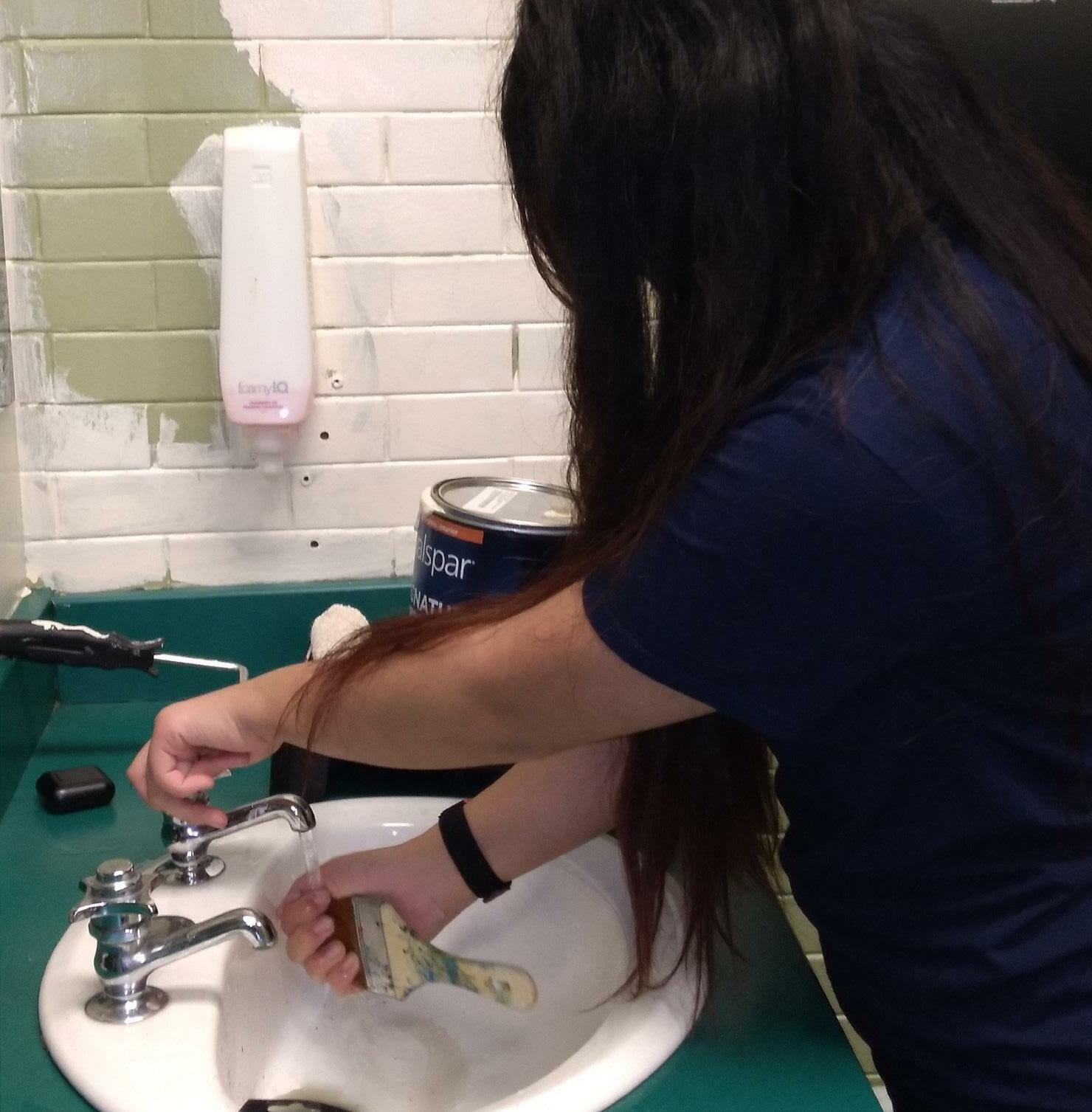
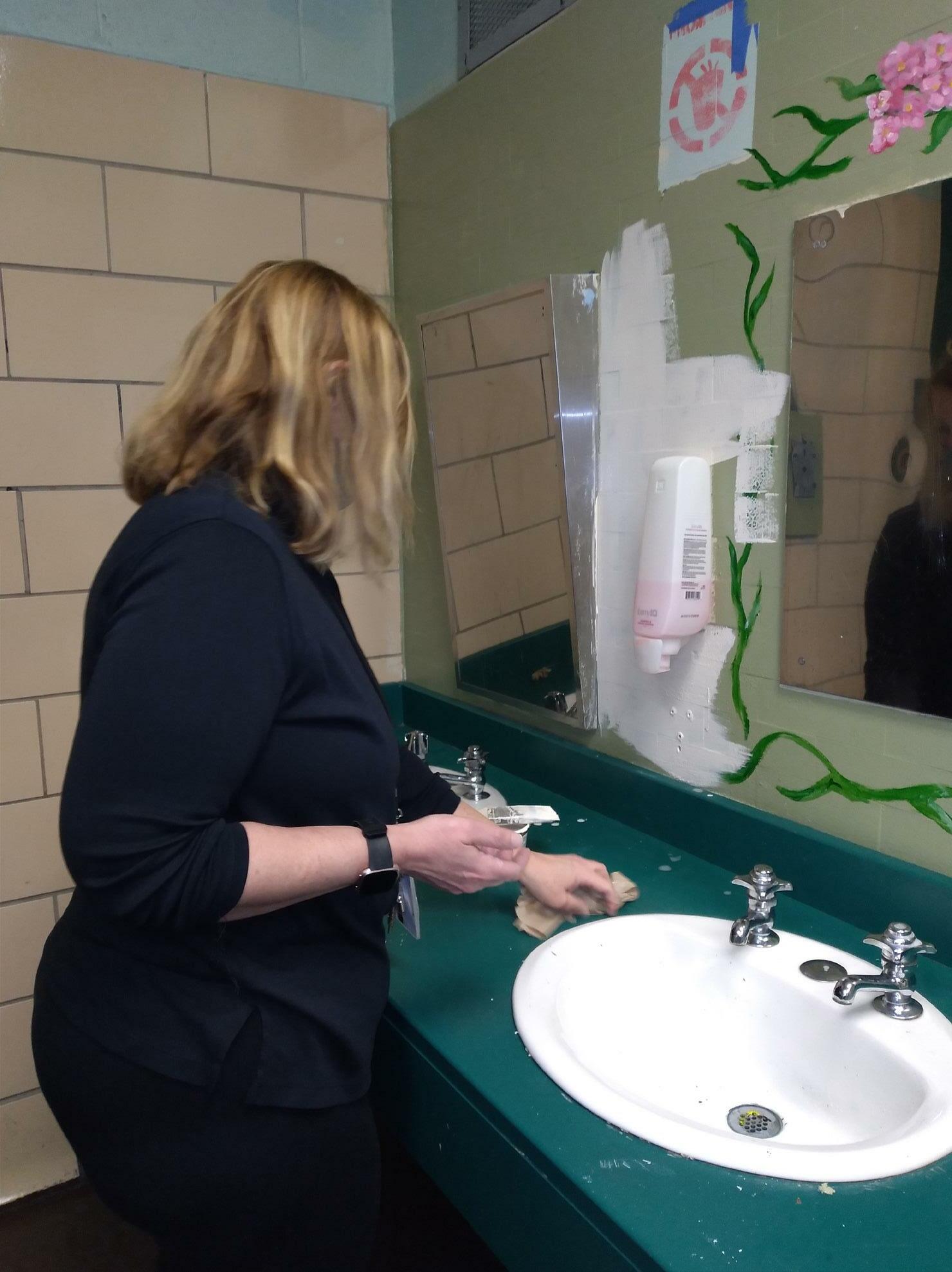
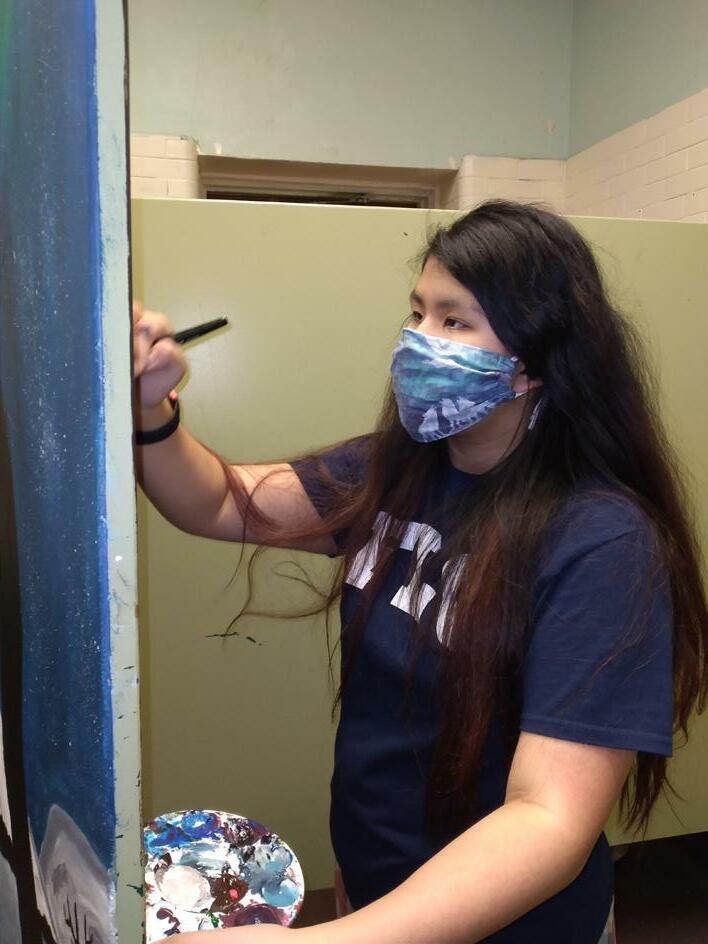
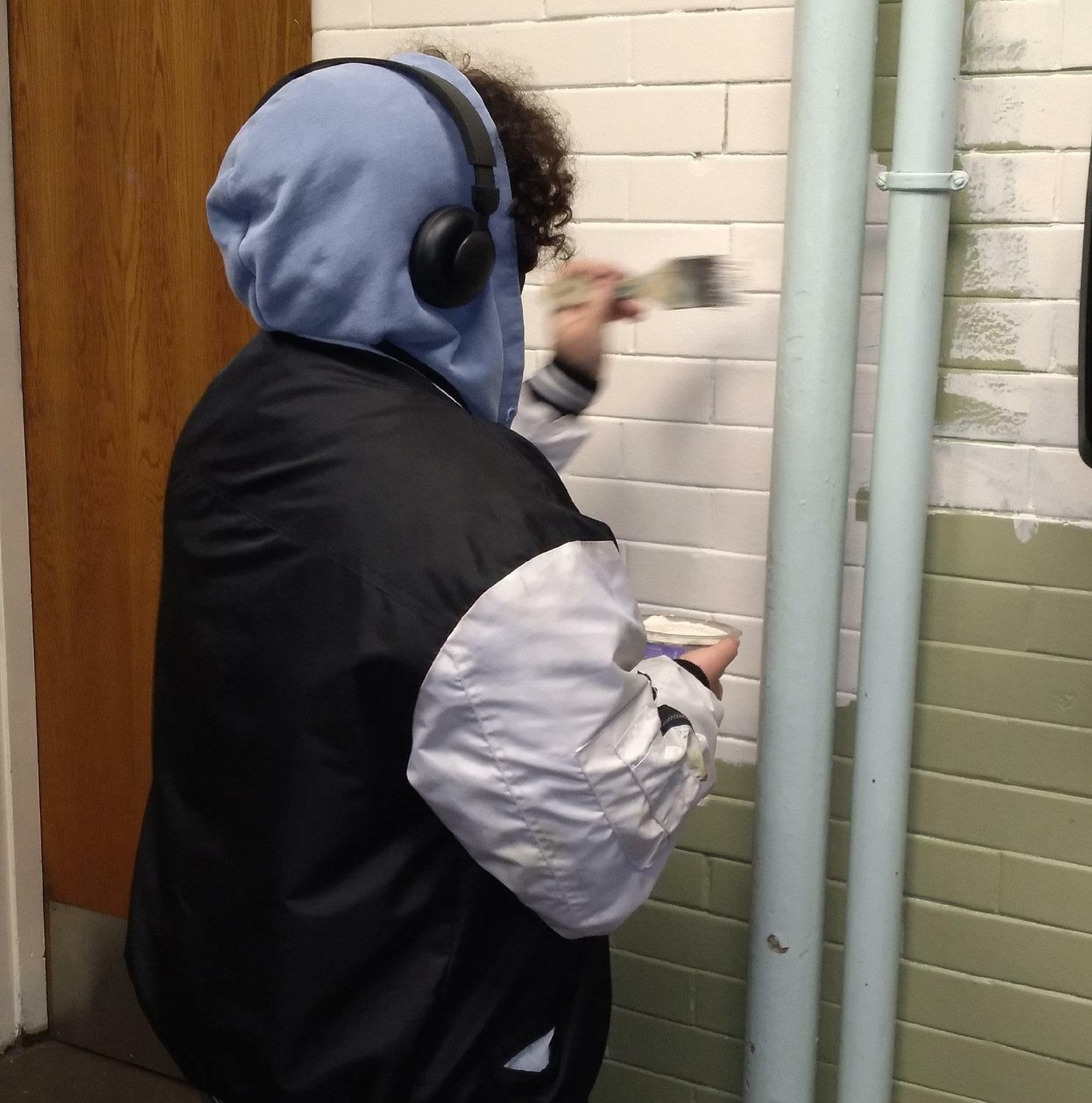
If you’re gonna join the Mural Club, you should probably know a little bit about the teacher who runs it. Ms. Whitt is an art teacher who has been described by Hajali as “a very sweet person,” and “very com fortable to talk to.” Murals used to be as
signments for Ms. Whitt’s students, but it started spilling into afterschool time and various majors began attending. Talking to Ms. Whitt about the Mural Club, she wanted it to be clear that “All different lev els are welcome..Sometimes people think that they have to be an art major or they have to have a lot of experience and you really don’t.” Ms. Whitt has watched the students who painted her earliest murals, like the ones near the cafeteria, grow up to be in their thirties! Rest assured, your art work, if you decide to join the mural club,
will last a while. She also mentioned that Philadelphia is known for its public art like murals, graffiti, sculptures, etc. They’re all over the city and it’s a great thing that the Mural Club falls in line with the traditions. Since the beginning of the pandemic, The Mural Club, like many other clubs in FLC, has shrunk significantly and is now overlooked. The Mural Club could be a great fit for students who love painting but are more reserved. It’s the perfect space for people who prefer comfortable and quiet spaces to share their creativity after school.
Anthony Guidice, Assistant Principal at Franklin Learning Center, sent out a Goo gle Classroom message on February 8th for all graduating classes informing stu dents of the consequences for cutting class.
The statement reads as follows: “Due to increased class cuts, we have determined that students require a consequence for cut ting classes. Beginning Monday, February 14th, we will run the class cut report daily. If your name appears on this report, you WILL be assigned an after school deten tion from 3:00 - 4:00 with administration in the cafeteria. YOU WILL BE INFORMED ABOUT YOUR DETENTION THROUGH YOUR SCHOOL DISTRICT EMAIL.”
Many FLC students are frustrated about the new policy. While a significant percent age of FLC students agree with the new pol icy, a survey of current students conducted by The Flash reveals that 64% are opposed.
Despite the opposition, though, FLC administration still sees the policy as a way to improve conditions in the school.
“We have lost more and more teach
ers,” Guidice said, “and losing teachers, we have substitutes and other people covering the class, and when the assigned teach er is no longer there, students tend not to go to their class. As a result, we have an increase of students walking the halls and an increase of instances such as fights and things that are inappropriate to go on in this school building. So, as an administra tor, it’s incumbent upon me and the rest of the administrative team to come up with plans, even if they’re late in the year.”
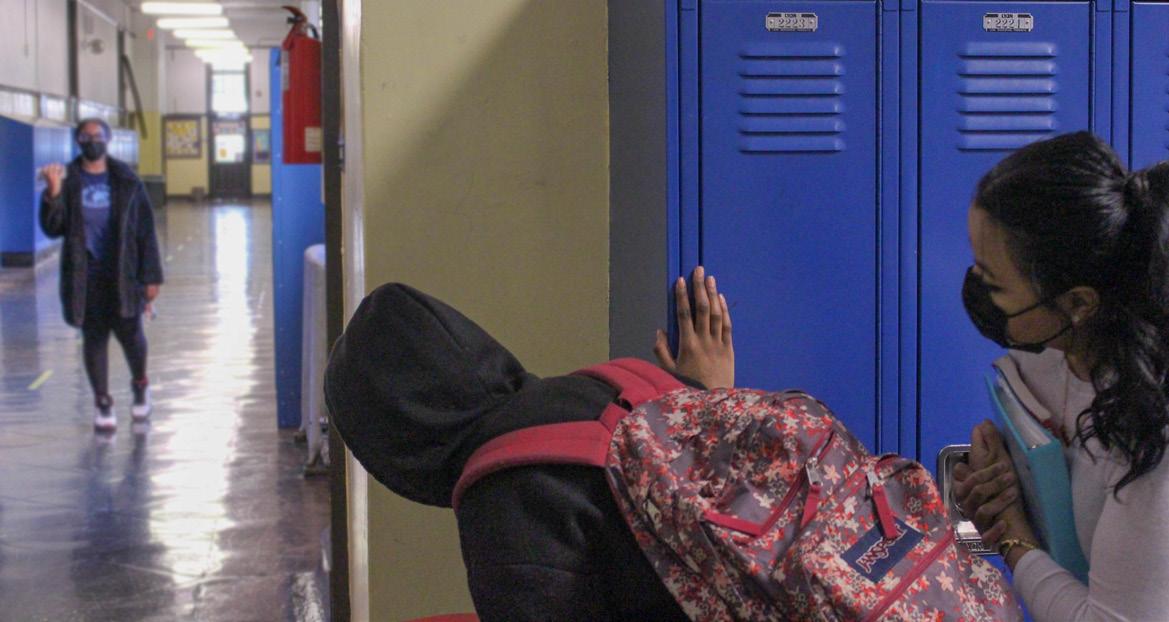
Seniors expressed their displeasure with the new plans at a March 8th town hall meeting in the auditorium. At the meet ing, Principal Nicole Lee announced that students who miss their advisory period will be marked as cutting, a decision that will impact Seniors’ eligibility for prom and also the number of tickets students will receive for their graduation ceremony.
Students at that meeting imme diately raised their hands to bring up the unreliability of SEPTA’s buses and trains, as well as a list of other reasons a student might be le gitimately late. Get ting punished with a deten tion should only happen when a student skips full instructional class periods, not when they come into school late after an advisory. Lateness should be punishable
depending on frequen cy. Lateness es, the ones due to public transporta tion, should not be pun ished as it’s out of the stu dents’ hands. However, it is fair that those students who consistent ly arrive late to school, missing class time, should receive con sequences as it seems to be a regular thing for them.
Discipline is needed in the school, es pecially because cutting classes is not fair to the teachers who are expecting their students to show up and learn. The new policy would be a good way to con trol students’ attendance levels if it took into consideration that not every stu dent goes out of their way to be late.
When asked about students’ con cerns about getting detention for missing advisory, Guidice had a dif ferent answer than Principal Lee.
“Advisory is not being counted as a cut when I run my cut report,” Guidice said. “I remove any homeroom cut off of the list.”
Here’s the problem with being a stu dent at FLC right now: it feels like one
As missing assignments once again start piling up and students cry out in frustra tion, we’re left to wonder what went wrong.
Over the years, our school system and curriculum have changed and adapted to our new generations and ways of living. This has been especially clear to see as the COVID pandemic broke out. As of the 20202021 school year, the whole district was shifted to remote learning. Students were essentially responsible for managing their academic learning on top of the hard times of the pandemic. As the new school year of 2021-2022 approached, students were granted the reward of in-person learning once again. This gave students a chance at maintaining regularity in their lives despite the pandemic. It was a chance at normality.
But as of recently, it appears that noth ing has changed. The norms of virtu al school and in-person school seem to have blurred together. Now, most class rooms have entirely shifted to technol ogy as a way of teaching and learning.
Assignments are easily accessible from resources such as Google Classroom. Of ten, the assignments have clear instructions written in the description, making it easy to understand what the teacher wants with out them physically telling the students.
With so many virtual assignments, it seems that students can get all of their work done at home without a teacher’s live in structions or help. As a result, in the class room, students are becoming less engaged and active. They are constantly distracted, zoned out, disconnected, and they are start ing to realize in-person is entirely pointless.
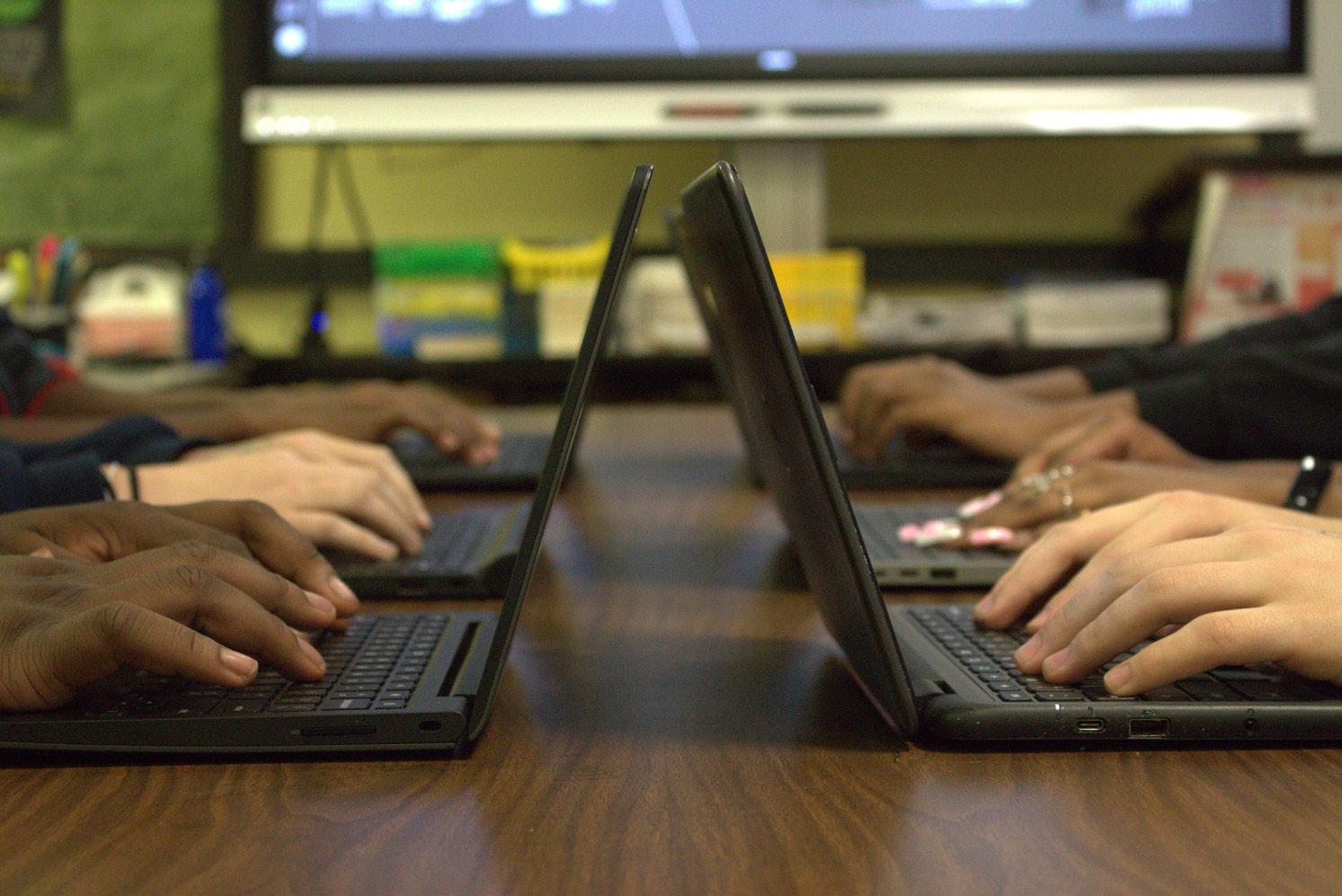
When asked if in-person school, right
now, learning-wise, is the same as it was be fore the pandemic, student Bayan Hajali said “I feel as though since we got used to virtual, in-person school had gotten more difficult.”
Another student, Connor McFarland, said “While I like the convenience of the
stitute for establishing this, but it’s the same as virtual: “Hey I’ll do this part, you do this, and we’ll never speak again.”
Even as teachers shift to electronic teaching, relationships aren’t the only thing being damaged, so is a student’s education.
person is telling us one thing and another person is telling us another thing. Com munication is rare and clear communi cation is even rarer. Policies are unveiled with short notice and information is of ten only shared once via loudspeaker or Google Classroom. The school lacks the ability to communicate clearly with its stu dents, leaving us frustrated and confused.

The idea of a detention policy is not the problem. Some students are excit ed to imagine calm hallways and a lack of screams and distractions. But no pol icy can succeed without clear commu nication. This is why the administration should hold off on new punishments until they have issued clear communica tion to students and staff on exactly what the policy for those punishments will be.
problematic. Constantly being on comput ers as a result of electronic learning affects physical health, lessens social interactions, and changes academic performance, caus ing students to have trouble completing assignments, fall behind due to failing grades, and potentially repeat a grade.
There’s also a technical problem to electronic teaching: dead laptops, com puter crashes, slow connections, etc.
While there’s a bunch of negatives to electronic teaching, teachers have found some positives. For example, Physics and Math teacher Mohamed Ould Babaali says “Virtual learning in creases teachers’ preparation time…”.
Others, like Medical Assisting teacher Erin Flynn-Klepczynski, said that prior years when students or teachers were ab sent it caused both teachers and students “...trying to play catch up” when instead a lot of time could’ve been used for teaching. Now due to how times are now in school and the incorporation of technology into classrooms, it has “...allow[ed] for students to receive the information at the same time.”
laptop, and enjoy not carrying all the books, I feel like teachers overly rely on [electronics]. A lot of teachers are teach ing through the laptop instead of teaching to the class, and that, I believe, is affecting students’ grades, and school experience.”
It’s not only students becoming discon nected from society–teachers are too. As teachers start relying on technology, they discount the importance of establishing conversation and relationships with stu dents. Group projects might act as a sub
Electronic teaching mostly benefits an in trapersonal or solitary learner, someone who prefers learning on their own. Though, electronic learning can be a disadvantage for linguistic/verbal, spatial/visual, and au ral/auditory learners. Electronic learning simply doesn’t cater to all types of learners. Take, for example, the students regularly falling asleep in class due to the resources being used that don’t pique their interest.
The list of problems of electronic learn ing isn’t short, in fact, it seems that it’s very
Now there’s a bunch of solu tions or alternatives that could take place. However, it is up to us, as a school community, to call for them.
French teacher Amy Garcia sug gests that although “some students found online school to be incredi bly challenging, others preferred it.”
In order to make sure that students get the best of both worlds, Garcia says we should “ask which aspects of each format are most beneficial and incorporate as many different avenues for learning as possible.”
In 1967, a group of 3,500 Philadelphia students marched down Broad Street to the Board of Education, hoping to protest for Black rights and Black studies. Among their demands: the right to wear tradi tional African clothing in school and the right to learn African American History.
In 2005, Philadelphia was the first city to mandate African American History for high school graduation and is among the few cities in the United States that has this requirement today. African American History is not only important for African Americans to understand their culture, but also for all students to understand the deep ly rooted racism that affects not only Afri can Americans but other groups as well.
Although Philly schools now have Afri can American History in their curriculum, many students have yet to have a true un derstanding of African American Histo ry and culture in the way that it’s taught.

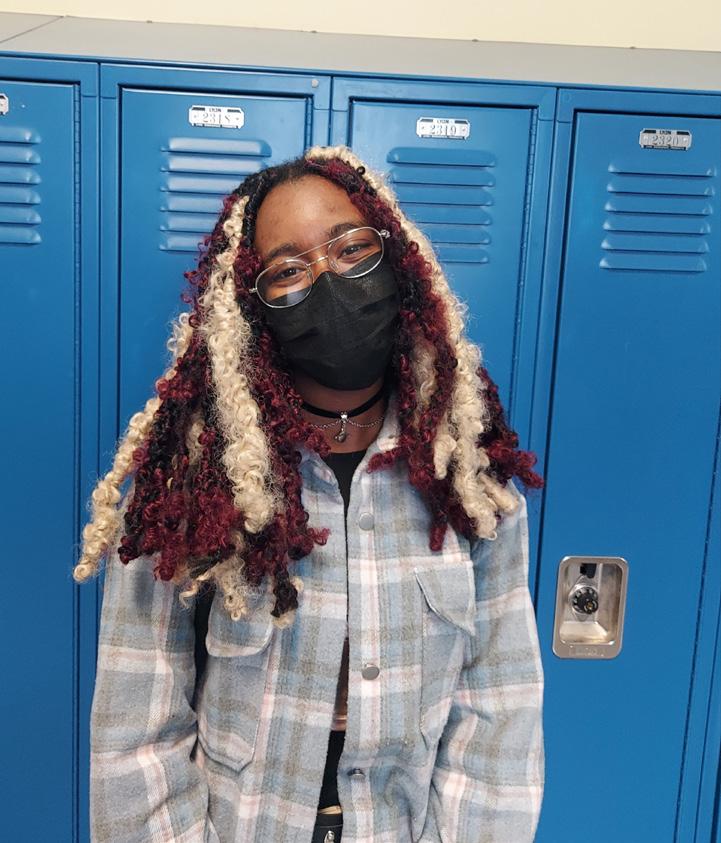
Bethlehem Belete, an 11th grade music major at FLC, knows that Af rican American History course con tent is not always explored even though it is a graduation requirement.
“They’re doing a good job by making it a requirement to take African American courses,” Belete said. “But then again, it’s still kinda watered down. They don’t give us the full truth...I don’t know, it’s like they give you points, but not everything makes sense because they leave out so much.”
Serenity Charity, another 11th grader at FLC, started learning about African Amer ican History before coming to high school.
“I think they started in fourth grade,” Charity said. “They would start talking about how people are slaves…they didn’t really get into like the nitty gritty until this year because usually people just kin da stop there and they continue doing that for every single year and you nev er really learn much, it’s the same thing.”
This shows a concerning trend in the teaching of African American History where students, despite hav ing the course available to them, may only learn as much as their teach ers are willing, or able, to teach them.
Ismael Jimenez, a Social Studies cur riculum specialist at the School District of Philadelphia and a professor of Afri can American History at the University of Pennsylvania, has a clear look at how African American History is currently being taught in schools in Philadelphia.
“We fall into this trap of looking at Black history as like Africans right, briefly gone over (if the teacher goes over them) start[ing] at slavery,” Jimenez said. “Then it goes into like, you know, Moses led some
people to a promised land, Abraham Lin coln freed the slaves, a dude made peanut butter (even though he didn’t), Rosa Parks sat on a bus, Martin Luther King had a dream, and Barack Obama became presi dent. That’s literally what a lot of students right now are taught in the required course.”
According to Dale Mezzacappa, se nior reporter at Chalkbeat Philadel phia, “the district has not significant ly changed the course, which is taught in the 10th grade, since introducing it in 2005. It uses a standard textbook that was last updated in 2011, and the course’s rigor, focus, and content have largely depended on individual teachers.”
This backs up the fact that the course lacks depth and fails to adequately teach students about Black history. The course’s focus and content being dependent on the teachers is a problem because those
“I’m one of those people that believe Black history is not American History,” Jimenez said. “It’s a unique story of a group of people from multiple backgrounds that has a different storyline about what Amer ica means. To place it within the context of America, I would argue, would white wash it and turn it into something that fits into the white storyline. If anything, African folks, Black folks have been vic tims of their own humaneness towards people who have dehumanized. So I think having a separate storyline is necessary.”
Jimenez wants African Ameri can History to start much earlier, too.
“The children, as young as kinder garten, should be getting exposed to Af rican American History, first, second, third–by the time we get to the gradua tion requirement, we should be talking about the intellectual genealogy of dif
“If they incorporated more into Ameri can History,” Belete said, “I think it will help people see the bigger picture. And see…the contributions of African American people throughout the history of the United States.”
Charity sees both sides.
“It is African history because mass amounts of people were stolen,” Charity said, “and that affects them, their economy, all of that, especially in the long run. But at the same time, it’s American history because that’s how our nation was built. So I think it’s right to include it but there’s a way to do it.”
Dr. Robin Vann Lynch is an Afri can American History teacher at FLC and she doesn’t think we have to choose.

“For me, the best education is inter disciplinary education,” Vann Lynch said. “So, I think it’s a both and. It should be integrated and it should also stand alone in some cases…. You get a lot of val ue [out] of a standalone course in high school because students are at a pivot al point in terms of their knowledge and their understanding of various topics.”
Dr. Latrina Stewart, Assistant Principal at FLC, sees good reason to incorporate Afri can American History into US History class.
who teach African American History are only required to have a Social Studies de gree. No prior African American History exposure is required. Some teachers who are passionate about the subject may go above and beyond to teach their students while others with no prior exposure or who might not be comfort able teaching some of its content, may only scratch the sur face of what students should be learning.
But, what is the best way to teach African American History? Should it be incorpo rated into American History? Some states do not even have Afri can American History in their curriculum.
Jimenez doesn’t think African Ameri can History should be taught in US History class.
ferent theorists and philosophers of Af rican descent across the world in order to make better sense of who we are and what it means to be human,” Jimenez said.
Thomas Magliaro, a World His tory teacher at FLC who previous ly taught African American Histo ry at a different school, agrees that African American History should be taught separate from other history courses.



“African Americans in the United States have had a large impact on the way our histories unfolded,” Magliaro said. “All the major accomplishments that we have achieved as Americans largely have start ed, or have been on the backs of African Americans, on the labor of African Amer icans, on the ideas of African Americans. I think that if you want to do African Amer ican History justice, if you really want to get deep into it and really understand the full picture, that you would be doing it a disservice by just including it in US Histo ry, or just including it in World History.”
But, after taking a few years of his tory classes at FLC, Belete has a dif ferent idea of how African Amer ican History should be taught.
“Yes, it should be a part of American History,” Stewart said. “And the reason why I say yes is because it is American Histo ry. All of us, no matter where our forefa thers originally came from, we are part of America and our history is American History. Again, I do appreciate the Phila delphia School District having the Afri can American History course for all high school students. But we are small, we are a district in a state of over 200 school dis tricts. So our students are getting it, but what about other students getting it? And the importance of everyone understand ing and knowing about African American History is it gives us a different level of ap preciation, whether you’re African Ameri can or not.… So I really do believe that it should be a part of just American History for all Americans and not just taken out.”
African American History should be incorporated into American History, not only because it is American History, but because people would most likely be more willing to learn about the course if it were incorporated. It’s fine to have it separated but it may make everyone think it’s dif ferent from American History. Moreover, African American History is critical to understanding American History. So, it is very important that African American His tory gets incorporated. It would not only give us a deeper understanding of Amer ican History but it would also give African Americans the credit that they deserve.
Do you have thoughts about the best way to teach African American Histo ry? Send them to flash@flchs.org and you may see them in our next issue.

We have a lot of diversity at Franklin Learning Center, but culture is never really celebrated. I remember in middle school we had a culture day. Everyone wore their traditional clothing, shared some traditions and facts they have, and brought dishes for us to get a taste of their culture. Here at FLC, we see bits and pieces of culture but not very often. It’s rare to see someone in their traditional clothing, but when it oc curs, it’s a beautiful and fascinating thing.
Going around asking if there’s a cul ture day set to happen during this school year, it seemed as though no one knew the answer. It was a little disappointing to hear Principal Nicole Lee say that “Unless


someone wants to take it up, no, a culture day isn’t set to happen this school year.”

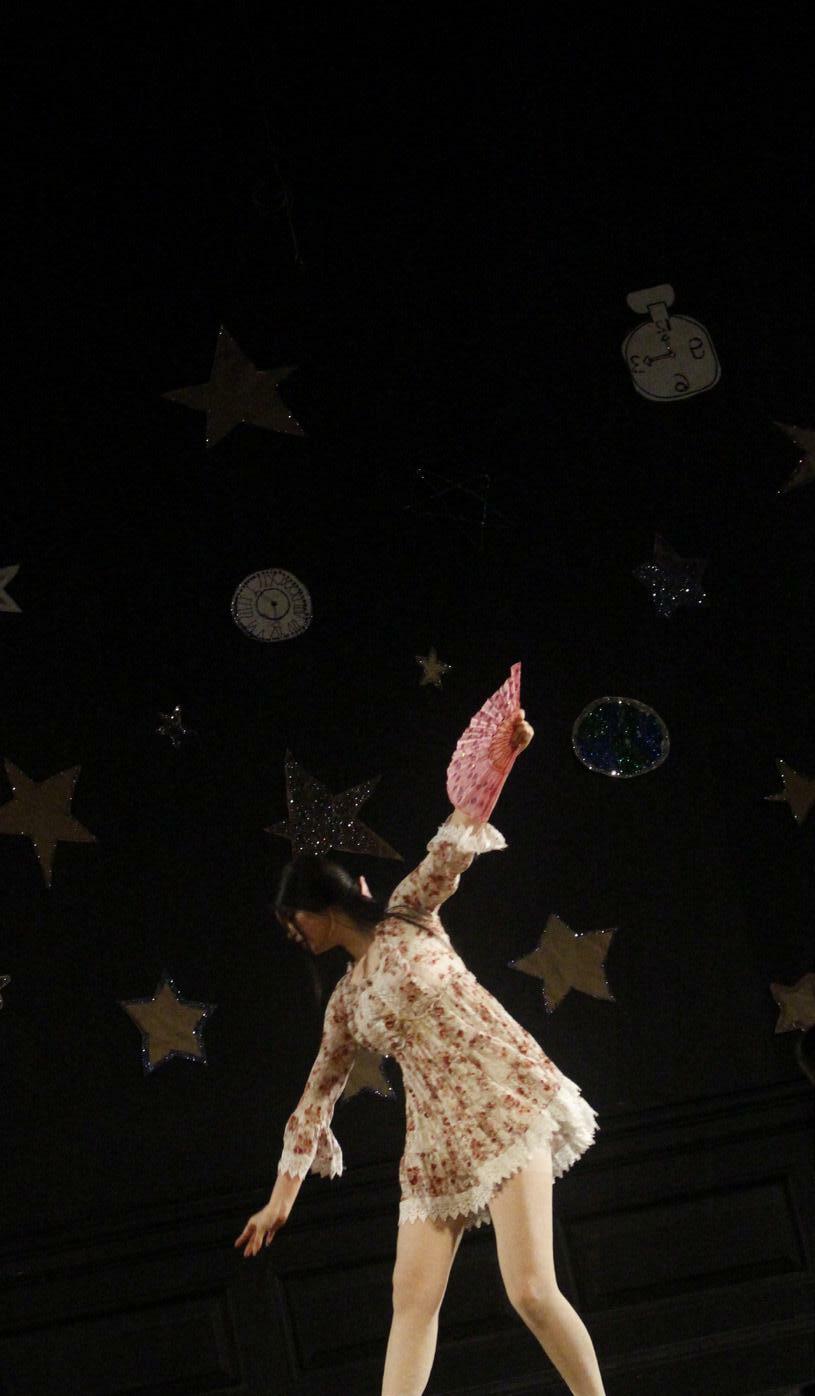
A culture day would not only be fun, but an opportunity for students to show or talk a little more about themselves and their culture. It should have been planned already and known about. It shouldn’t be something that is waiting to be picked up by students or teachers.
Growing up in a non-American house hold, culture was everywhere around me. From the food we eat, the clothes we wear and the holidays we celebrate to our table ware and routines. It was a great thing when I was a kid to be able to share a little of my home life with my friends and compare and contrast our differences and similarities. Some cultures share a multitude of things. Holidays are shared, food, even rou tines such as taking your shoes off at the door as a sign of respect. It was also a sad thing looking back. I felt exclud ed whenever Christmas came around, thanksgiving, easter, the list goes on. My holiday wasn’t put on the school district calendar until recently, a little disappointing to me. It was a frustrat ing thing to have to be absent in order to celebrate my holiday because on the other holidays, we had the day off.
I used to be so happy when someone asked me about why I had the day off because it gave me a chance to spread some information about my culture, it was something I looked forward to doing because I didn’t know any better. Looking back now, it angers me how no one knows anything about my culture unless I talk about it myself. I know about Christmas and Thanksgiving and Easter, but so many people don’t know anything about Eid. Why is that?
My middle school culture day hap pened every year. It was probably one
of the best days because it allowed stu dents to truly be themselves without any judgment. We had traditional dances that were put on and they were beautiful. I re member when I got to wear my thobe and was so happy to see other people wear ing their own thobes and their traditional clothing as well. We had a flag show too.
A number of students walked down with their country’s flags while wearing their clothing and it was amazing. I feel like it brought the school clos er together because you got to see who shared your culture as well as seeing the differences.

Organizing a cul ture day would not only make students informed about the cultures of their fellow classmates, but would also be looked at as an opportunity for students to give a little insight on how they and their family do things. How their culture works and what traditions they may have. Culture isn’t only about the food you eat or the clothes you wear, it’s your lan guage, your decorations, your social life: it’s ev erywhere around you.
We need a culture dayTalking about a cul ture day, when is ours? We don’t have one planned at the moment, but we can because don’t you want a culture day? tTo be able to get to know your friends more,
your teachers, ourthe staff members.? It’ll be such a great experience for everyone. Those who might have cultures that aren’t talked about as much and those who might have cultures that have been talked about for forever. We, as students, should want a day like this. A day to express ourselves outside of what people in school see. A day of no judgment. A day of pure excitement. A day of new knowledge. A day of learn ing. Isn’t that what school should be about?
In 2018, the School District of Philadel phia began a test to find all water outlets that contain considerable amounts of lead in schools. It made major news headlines and people seemed quite concerned. As time passed, public concern lessened. The topic has stretched on for about 4 years now. But what does lead poisoning even look like? Has the issue changed in the past few years?
Lead is a toxin that was commonly found in architecture in the 19th and 20th centuries. Lead’s toxicity has been known since Ancient Greece, but it kept being used because of how easy it was to convert. Lead could be converted into many differ ent forms including glass, paint, plumb ing, etc. People began passing acts to ban lead in products in the late 1900s, but its footprint remains in many high schools in the Philadelphia School District, including Franklin Learning Center High School.
Currently, only 29% of public schools in the School District of Philadelphia have been tested for lead in their water. Of that 29%, lead had been detected in about 98% of them. They’re detecting parts per bil lion(ppb) of lead, yet minute levels of lead can have harmful consequences as well. There is no safe amount of lead that can be consumed. If the water fountains fail the test by exceeding a certain amount (10ppb), they’ll be shut down until lead levels go down. Note that 71% of public schools haven’t finished or haven’t started their tests yet, and many of the schools who have, haven’t released all of their results into the public domain. Leaving the pub lic with not much information to go off of.
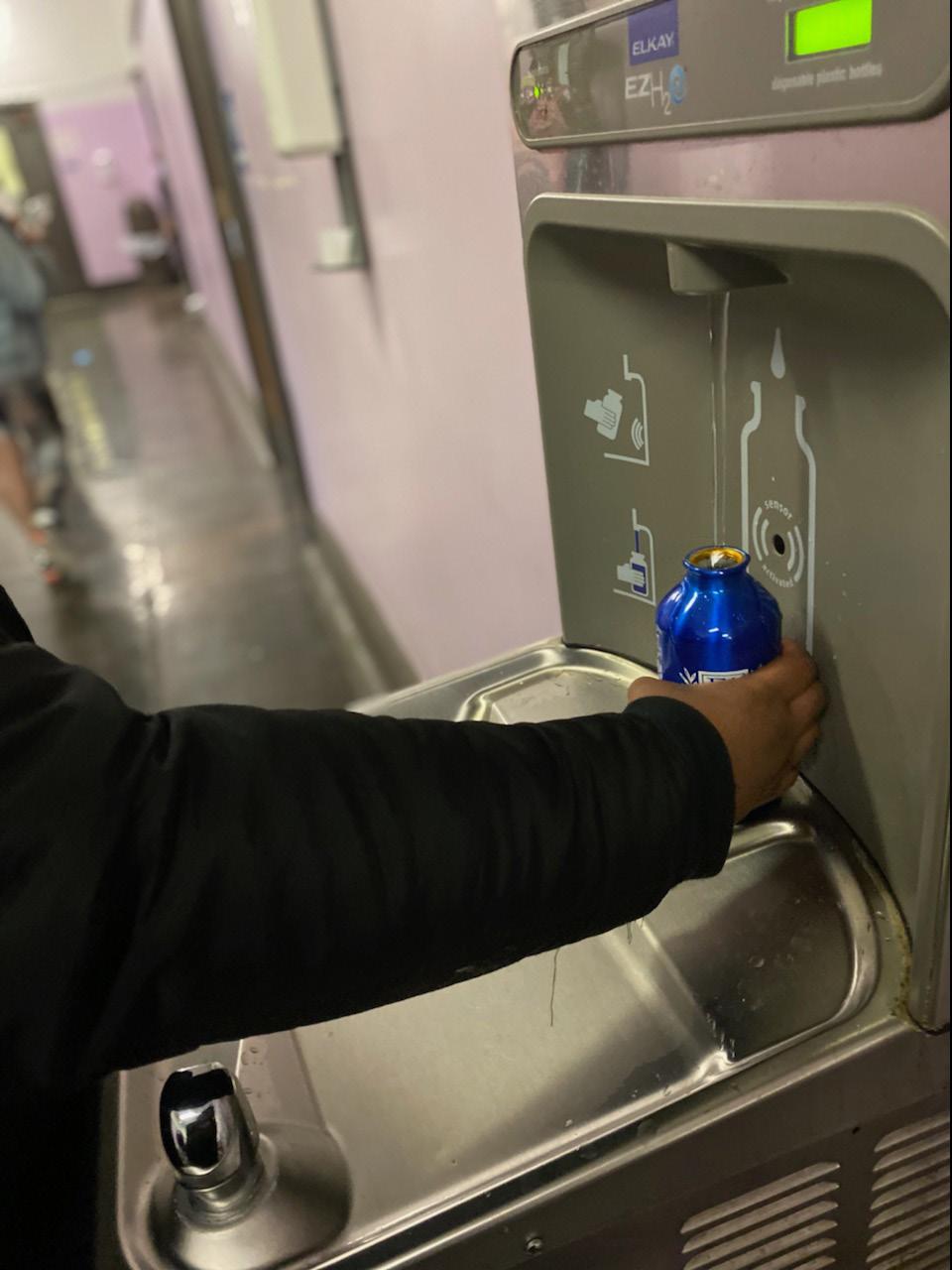
Though lead poisoning is rare, lead can cause significant damage if around for long periods of time. Lead isn’t just in plumbing; it’s in the paint as well. Paint that has still yet to be removed in many schools in the Philadelphia School District. Symptoms of lead poisoning can manifest in a devel
opmental gap, difficulty compre hending topics, irritability, hear ing loss, seizures, and a range of many other things. People could have lead poisoning without any symptoms which can cause it to go untreated until it’s too late.
As stated previously, the lead problem in the school district has lasted for about 4 years now, yet substantial change has yet to be made since less than ⅓ of schools have been tested. FLC alumni (...)” wrote an opinion piece on this topic a few years ago labeled “Education First, Safety Second: The Cost of Going to School at FLC”. It goes into greater detail on lead in the water fountains in FLC in particular, and also the school’s conditions. They mention in their article that in 2018 “Pen nEnvironment Research graded the state of Pennsylvania with an “F” for lacking required testing.”
The School District issue only reflects a broader, more wide spread problem. High levels of lead can be found in homes, but home sinks have filters that pro tect families. Fortunately, schools have begun replacing water foun tains with water stations that have filters and have begun giving out water bottles yearly. This doesn’t change the lead plumbing prob lem, but it does ease it slightly.
In short, lead has been a problem for the School Dis trict of Philadelphia for a long period of time and some mea sures are being taken to con sole the problem yet it seems to be going slower than expected.
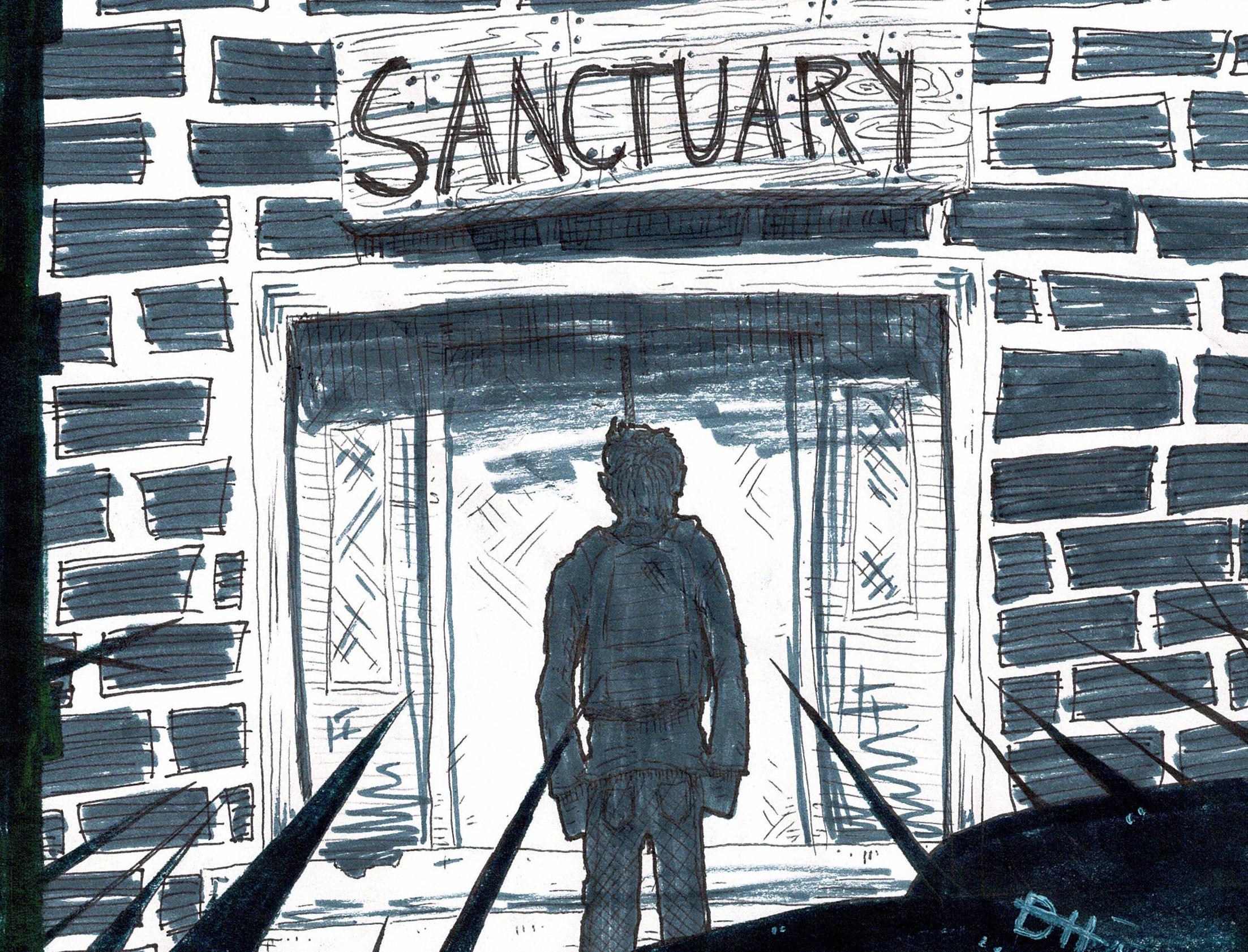
On Tuesday February 22nd, 2022, Su perintendent Dr. William Hite issued an email to all teachers and staff in the School District of Philadelphia. The email contained an up date about the Wel coming Sanctuary Schools Resolution Plan following the recent news re garding Russia and Ukraine. This plan ensures all students coming in will be protected from im migration enforce ment. In the email, Hite states that Immigration en forcement agents will not be permit ted at any school or remain on school grounds, except under emergen cy circumstances.
District em ployees, volunteers, and contractors are prohibited from asking or sharing with immigraton
Any request made by an immigration enforcement agent for information, obtain ing documents or to visit a school site, must be immediately forwarded to the Office of
The Philadelphia Department of Pub lic Health announced an error in their vaccination data collection on Wednes day, March 9th. 53.6% of children ages five to eleven were previously stated to have received one dose of the COVID vaccine, but it turns out that only 34.2% have really started their vaccination.
26% of children ages five to eleven re ceived second doses of the vaccine, ac cording to the Wednesday admission. A little over 75% of Philadelphians 18 and older are vaccinated, which is less than the 82% originally reported by the PDPH. The news broke on the first day that the School District of Philadelphia lifted the mandatory mask mandate.
City Health Commissioner Cheryl Bettigole and deputies knew about the error in the data as early as February 16 but decided not to address it since vacci nation percentages are not a part of how the city determines masking guidelines.
“From our perspective,” PDPH Com munications Director James Garrow said, “the vaccine rates have nothing to do with our mandates because...we want the man dates to be predicated on what’s actually happening to the virus on the ground.”
The city hired a second epidemiology team to review their monthly data to help it correlate with their weekly checks. This new team will help overlook their information thoroughly so mistakes won’t occur again.
General Counsel for review and guidance. This means that every school in the School District of Philadelphia will be come a Sanctuary School for immigrant students. Schools will accept and protect students of immigrant and refugee families.Illustration: Student walking into a sanctuary school. Staff Illustrator Dylan Howe. By: Kyndra Patterson and Phatamarha Noel

The Philadelphia School District has had a flood of new members to their PTA meetings wanting to discuss many topics. One of the most prominent topics being Policy 252. Numerous meetings have been called regarding whether or not it should be revoked. Meanwhile, more and more school districts have been trying to instate Policy 252. Ongoing debates about Poli cy 252 are still being continued, but what exactly is it and why is it so controversial?
Policy 252 was released in 2016 and con tains a plethora of codes. The following are some of the codes mentioned in Policy 252. Allowing students the right to change their name and pronouns without their parent’s consent. Encouraging gender-neutral terms as well as encouraging the dispense of ac curate health education. Allowing students to keep their gender identity, assigned gen der, and legal name confidential. Access to
restrooms and locker rooms that students are the most comfortable in and prohibit ing gender-segregated activities, discrimi nation of any kind, and gender-segregated dress codes. The principal goal for policy 252 was to educate and protect students, especially those in the LGBTQIA+ spec trum, but many fear it’s doing the opposite.
The controversy that surrounds policy 252 is mainly with districts and individ ualized schools that want to revoke the policy. Some parents and guardians in the Philadelphia School District want it re voked as well. They don’t want their chil dren to change their gender identity and it interferes with their spiritual or religious beliefs. It isn’t what they’re accustomed to, making it seem offensive from their point of view. They find no need for gender-neu tral uniforms and gender-neutral activities.
However, there are other parents and school districts who don’t particularly agree with those opinions. They have as serted that many students’ school envi ronments will benefit by allowing students
to be at ease. Allowing students to be com fortable with themselves can lead to better academic performance, which is what al most every parent wants and what school districts strive for. They also argue that the lack of acknowledgment for LGBTQIA+ students has caused generations of emo tional, mental, and even physical trauma.
Some parents have turned to a study made by a nonprofit organization named, “The Trevor Project,” which found that teens in the lgbtqia+ community are about 4 times more likely to commit suicide. It was also found that gender non-conforming and transgender youth who were allowed to change their name on record had reported to having lower rates of attempting suicide.
Though Policy 252 is mandated throughout the School District of Phil adelphia, there’s no guarantee that it’s enforced in every school. Students who should be protected from dis crimination and harassment are not.
The policy isn’t clear on the punishment for people who violate the rules, which
seems to be a substantial flaw. Nonethe less, the policy does a thorough job of defining many different terms that have been generating quite a bit of confusion as of lately. It differentiates terms such as assigned sex, gender identity, and gender expression. As well as defining both stu dents’ rights and expectations of teachers.
The School District of Philadel phia and the schools themselves are responsible for enforcing these laws.
While the topic of Policy 252 is quite controversial at the moment, we’d love to hear your thoughts. To give your thoughts on the matter and on Federal decisions in general, go to https://www.regulations. gov/. If you want to learn more about your rights as a student, you should definite ly go to the philasd student rights page at https://www.philasd.org/studentrights/. If you’d like to know more about Policy 252 in particular then analyze the philasd’s pdf at https://www.philasd.org/src/wp-con tent/uploads/sites/80/2017/06/252.pdf.
 By: Luis Lozada
By: Luis Lozada
Since March 2020, the “true” beginning of the COVID-19 pandemic, many things have been up in the air in a vast amount of different ways states and counties have dealt with this serious issue. The situation that has now arisen is how contradicto ry these plans may be. For a while, the right to consent to the COVID-19 test or vaccine has varied county by county and their laws. Currently in Philadelphia mi nors have the right to consent to have the covid vaccine which is great because it gives minors the right to choose whether or not they want to have the vaccine or not. This issue – which could seem not as important to others – in other plac es they don’t give minors the option or opportunities to do the same and have to get a parent or guardian’s permis sion, this leaves the minor’s without legal rights for their own medical well-being.
The heavy misconceptions around vaccinations has caused many people, in cluding parents and guardians, to com pletely avoid the COVID-19 situation altogether. These laws can become very controversial since the right to medical autonomy is being altered, many teens may have contrasting opinions to their elders and the vaccine has now become a requirement to do many things in these times as well as to even being able to eat out. So the question is, is it fair that teens are not allowed to make the conscious de cision as far as their health to take it or not, because by not taking it there are many risks and by taking it there are risks as well.
Ms.Way, FLC medical teach er, shared her perspective on the topic in shorter words was that many teenagers are very intelligent and there have been many cases where kids do become med ically emancipated, for example if a teen becomes pregnant they have that right to choose what their next step may be. But teens are smart enough to do their own research and have that ability to choose whether or not to get the vac cine regardless of their parents opinion. Continuing on this idea of weath er or not the vaccine can be dangerous, let’s talk about the statistics behind these ideas. A study conducted in 2021 people who have been fully vaccinated have had a lesser chance of getting Covid -19, out
of 100,000 people fully vaccinated only 125.4 people have caught COVID and only 4.9 of them were hospitalized this is vs 10,000 people who weren’t vaccinat ed 369.2 cases were found and 18.2 were hospitalized according to Statista.com
As far as a day-to-day basis of not being able to interact with other people and go out to do things can be daunting on mental health since, most likely, people would be stuck inside doing nothing and of course, taking it has its risks as well and it’s not like covid cannot still be contracted but the chances are proven to be reduced.
The bigger question is while it may be true it is typically required to have parental consent when it comes to medical decisions for a child who hasn’t reached the legal age of 18, is it fair to push that idea when the magnitude of the situation is always esca lating and de-escalating randomly? The re ality of this is if people don’t get the vaccine and they contract COVID-19 it can con tinue to spread and that’s why COVID-19 guidelines and mandates have been so strict. By referring to the information from statistia.com, people who have gotten it have had way lesser chances of contract ing covid and that’s just by the amount who had gotten studied, so on a larger scale the numbers are theoretically similar.
In conclusion, the idea that the covid vaccine is dangerous isn’t necessarily true. Many people would normally bring up the fact that yes the statistics are true but it still has covid in the vaccine. Well, medically speaking, that’s what a vaccine is. If you search up the correct definition of vaccine the definition states the follow ing “A vaccine is a biological preparation that provides active acquired immunity to a particular infectious disease. A vaccine typically contains an agent that resembles a disease-causing microorganism and is of ten made from weakened or killed forms of the microbe, its toxins, or one of its surface proteins.” which means all vaccines have an agent that is or resembles said disease so your body can grow accustomed and later on learn to fight against it. So the truth is, it’s just like any other vaccine, while it may be true it was in the testing stage in the be ginning of the COVID-19 pandemic, it has progressed and been proven to be just as effective as any other vaccine you’ll typical ly receive. The decision to take the vaccine is one hundred percent up to that person.

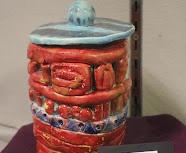


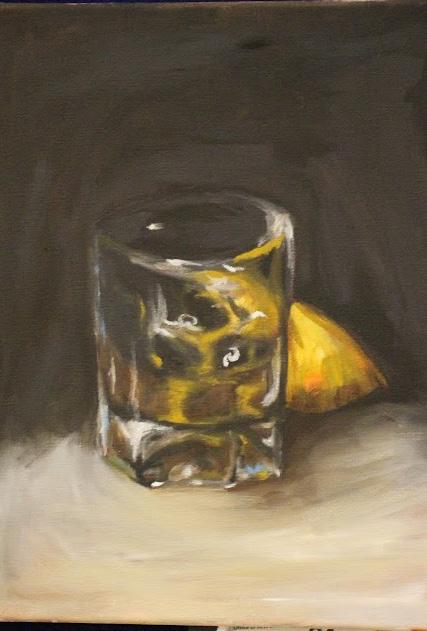




This is a gallery of phenomenal art created by our amazing art majors. If you ever see them in the hallway, give them a round of applause!
